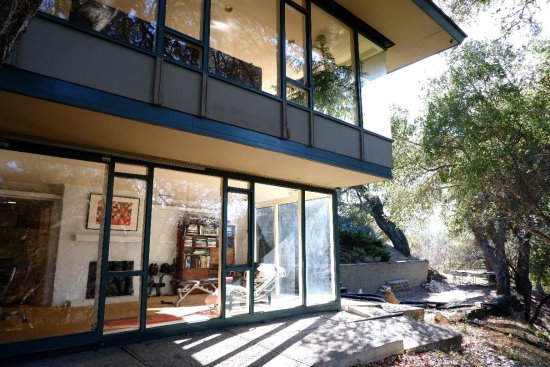 | | | Fully glazed window walls at the southwest corner, looking southeast. | | | | | | The decision on whether or not the residence at 12 Charles Hill Circle deserves to be designated as a historic landmark will now rest with the Orinda City Council, following the decision of the planning commission not to recommend to the city council that the designation be granted. The commission chose not to follow the recommendation of the Historical Landmarks Committee, which had voted to recommend the historic landmark designation. The planning commission action on the residence was considered at its July 21 meeting, and finalized at a subsequent meeting on July 27. Following the filing of an appeal by the applicants, Jeanne Huang Li and Nathan Ogle, the matter will be considered by the city council.
 The applicants seek the historic landmark designation for the residence that was built in 1951 by architect Paul Hamilton, who lived in the home and ran his business from it until 1961. The applicants claimed that Hamilton was an architect of local significance and that the home is a well-preserved example of the Second Bay Tradition, and Orinda staff and the Historic Landmarks Committee agreed. However, the planning commission struggled to find that Hamilton was significant, finding that he only worked on five homes in Orinda, and that none of the homes he had designed anywhere had been given historic landmark recognition. The commissioners also questioned the timing of the application, wondering why the applicant brought it forward when the home is still in need of repairs.
The applicants seek the historic landmark designation for the residence that was built in 1951 by architect Paul Hamilton, who lived in the home and ran his business from it until 1961. The applicants claimed that Hamilton was an architect of local significance and that the home is a well-preserved example of the Second Bay Tradition, and Orinda staff and the Historic Landmarks Committee agreed. However, the planning commission struggled to find that Hamilton was significant, finding that he only worked on five homes in Orinda, and that none of the homes he had designed anywhere had been given historic landmark recognition. The commissioners also questioned the timing of the application, wondering why the applicant brought it forward when the home is still in need of repairs.
 In order to be designated as an historic landmark, a property must meet at least three conditions set forth in the city code. The planning commission found that 12 Charles Hill Circle met only one condition, and therefore did not qualify for historic landmark status. The sole condition that the commission found applicable was that the building contains elements of architectural design, detail and materials or craftsmanship which represent a significant architectural innovation.
In order to be designated as an historic landmark, a property must meet at least three conditions set forth in the city code. The planning commission found that 12 Charles Hill Circle met only one condition, and therefore did not qualify for historic landmark status. The sole condition that the commission found applicable was that the building contains elements of architectural design, detail and materials or craftsmanship which represent a significant architectural innovation.
 The applicants had also advanced the work of renown landscape architect Lawrence Halprin on the property, but the commissioners considered that his contribution had not been significant and that much of the landscaping was no longer present.
The applicants had also advanced the work of renown landscape architect Lawrence Halprin on the property, but the commissioners considered that his contribution had not been significant and that much of the landscaping was no longer present.
 At the hearing before the HLC, neighbors of the applicants argued that the applicants were trying to prevent them from completing restoration of their properties on the grounds that it would affect the historic status of the applicants' home. Although staff did not dispute that the applicants had made that effort, they did repeatedly note that the historic designation would have applied solely to the applicant's property, and that it would not have influenced decisions on the neighbor's property. However, there is an outstanding issue of whether or not the applicants could force their neighbors to be subjected to more costly procedures for environmental impact reports under the California Environmental Quality Act (CEQA).
At the hearing before the HLC, neighbors of the applicants argued that the applicants were trying to prevent them from completing restoration of their properties on the grounds that it would affect the historic status of the applicants' home. Although staff did not dispute that the applicants had made that effort, they did repeatedly note that the historic designation would have applied solely to the applicant's property, and that it would not have influenced decisions on the neighbor's property. However, there is an outstanding issue of whether or not the applicants could force their neighbors to be subjected to more costly procedures for environmental impact reports under the California Environmental Quality Act (CEQA). |
